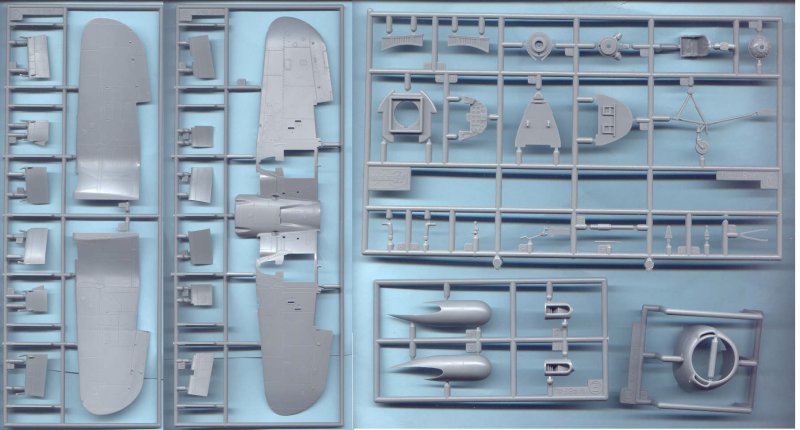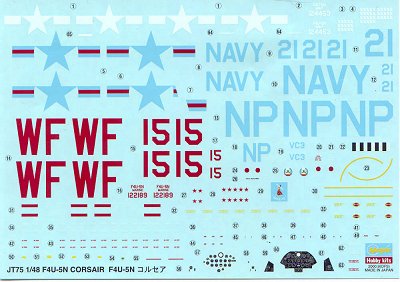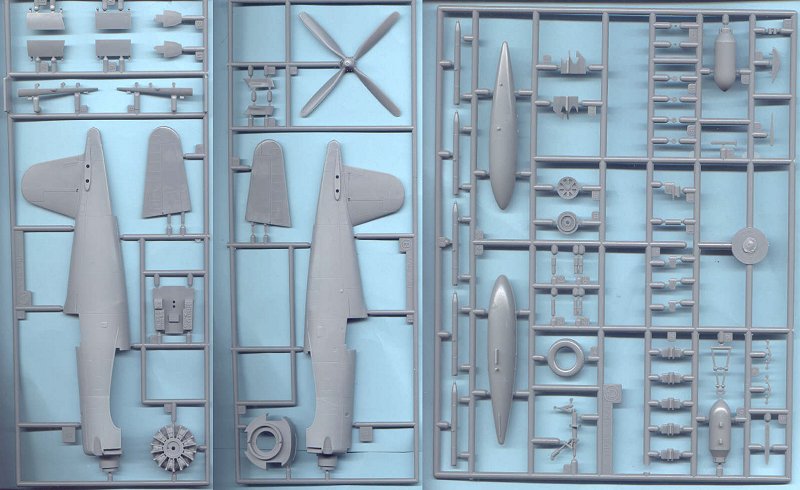
|
KIT: |
Hasegawa 1/48 F4U-5N Corsair |
|
KIT # |
9075 |
|
PRICE: |
$26.00 |
|
DECALS: |
See Review |
|
REVIEW & |
|
|
NOTES: |
|

|
HISTORY |
The F4U-5 was the ultimate Navy development of the Corsair series as a fleet defense fighter. The first prototype took to the skies December 21, 1945. It differed from previous Corsairs by having an even longer nose, a raised cockpit, and all-metal wings. Powered by a Pratt and Whitney R-2800-32W providing 2,450 h.p., the F4U-5 was the fastest piston-engine aircraft to ever operate from a USN aircraft carrier: 462 mph at 31,400 ft. Armament was upgraded from .50 caliber machine guns to four 20mm cannon as standard, with provision for two 1,000 lb. bombs and 8 5-inch HVARs. Of a total 568 F4U-5Ns produced between 1946-49, 223 were F4U-5, 214 were F4U-5N, 101 were winterized F4U-5NL, and 30 were F4U-5P photo recon aircraft.
The F4U-5N radar-equipped night fighter first went to war with VMF(N)-513, "The Flying Nightmares," in 1950. The aircraft first provided night close air support for the First Marine Division during the breakout from the Chosin Reservoir in November-December 1950. Following the ejection of U.N. forces from North Korea by the Chinese, the Corsairs operated in the night intruder role, attacking North Korean and Chinese truck convoys and supply trains.
The F4U-5N also served with the Navy's Composite Squadron 3 (VC-3), the Pacific Fleet night defense squadron, equipping four-plane night and all-weather fleet defense detachments aboard the carriers of Task Force 77.
"Lucky Pierre" vs. "Bedcheck Charlie":
Throughout the Korean War, the North Korean People's Air Fore managed to be a thorn in the side of the U.S. Air Force with nighttime nuisance raids mounted by Po-2 and Yak-11 light aircraft. The airplanes were wood and fabric, making them very difficult to pick up on radar. One Po-2 inflicted more damage on the USAF than the rest of the NKPAF combined when it bombed Kimpo air base in the Spring of 1952, destroying six F-86 Sabres and damaging ten others. A Marine F7F Tigercat of VMF(N)-513 scored the first success against the night raiders when CAPT E.B. Long and WO R.C. Buckingham shot down a Po-2 on July 1, 1951. In 1952 an F-94A Starfire managed to shoot down a Po-2 when the Starfire throttled back, dropping gear and flaps to stay with the slow biplane; unfortunately the Starfire immediately stalled and spun from the recoil of its guns, killing the pilot and observer. Another F-94 was lost in the summer of 1952 when it collided with a Yak-11. Jets were too much for the "Bedcheck Charlies," and a flight of four armed T-6 Texans were used in 1953 against them with no success. One June 16, the new Yak-18s being used by the NKPAF had their most successful night when two of them destroyed 5 million gallons of fuel in a dump in Inchon. The mighty Air Force was forced to ask the Navy for assistance.
LT Guy P. "Lucky Pierre" Bordelon, USN, was the commanding officer of VC-3 Detachment D, aboard the USS "Princeton" when the call for help came on June 17, 1953. Bordelon took two of the detachment's F4U-5N Corsairs to Kimpo, including BuNo 124453, his personal aircraft with the assignment of hunting the Bedcheck Charlies. Between June 29 and July 17, 1953, Bordelon shot down four Yak-18s and one Yak-11 over Seoul. It was the greatest success by one pilot against the North Korean raiders, making Bordelon the only U.S. Navy ace of the Korean war, as well as the only "all-prop" ace. Bordelon returned to the "Princeton," leaving 124453 at Kimpo to be flown by an Air Force pilot if there were any more raids. The Air Force pilot immediately totalled the Corsair in a daytime crash, due to unfamiliarity with "Old Hose Nose."
|
THE KIT |

A few years ago, Minicraft released what it called an F4U-5N in 1/48. The kit was universally damned as inaccurate and so bad that it could not be turned into an accurate model without considerable scratchbuilding by the modeler. Thus, when Hasegawa announced this past summer that they were releasing an entire series of late model Corsairs - the F4U-5N, F4U-7 and AU-1 - fans of the Corsair breathed a hopeful sigh of relief.
 The model comes on nine sprues of light grey plastic and one clear. Even if
the F4U-7 and AU-1 had not already been announced, it would be obvious they were
on the way from the fact that the cowling is on its own separate sprue, and the
ten HVARs provided (the F4U-7 and AU-1 both had ten underwing stations for
rockets). The parts are crisp and flash-free. The best description is "the
Tamiya Corsair without folding wings." The kit provides decals for the F4U-5N flown by LT. Guy P. Bordelon, and an all-black Marine Corsair of VMF(N)-513 flown by CAPT Eugene Derrickson in
1951.
The model comes on nine sprues of light grey plastic and one clear. Even if
the F4U-7 and AU-1 had not already been announced, it would be obvious they were
on the way from the fact that the cowling is on its own separate sprue, and the
ten HVARs provided (the F4U-7 and AU-1 both had ten underwing stations for
rockets). The parts are crisp and flash-free. The best description is "the
Tamiya Corsair without folding wings." The kit provides decals for the F4U-5N flown by LT. Guy P. Bordelon, and an all-black Marine Corsair of VMF(N)-513 flown by CAPT Eugene Derrickson in
1951.
Though Hasegawa has established a new level of cockpit detail with the release of the Tenzan, Hayate and Shiden-Kai models, the cockpit detail of this F4U-5N reverts to the quality level of the F-86 Sabre and P-47 Thunderbolts, i.e., adequate but not great. Fortunately, the fact that the cockpit of late Corsairs was painted black will hide some of the lack of detail, but there will certainly be room for True Details and other aftermarket companies to release a late-model Corsair cockpit (it's close enough to be virtually the same for all three). Marco Polo's representative informed me that they will release the kit with a Jaguar resin cockpit in the near future (I would guess after the new year). Don't get me wrong: the cockpit is adequate, and with seatbelts and a few scratchbuilt levers on the side panels, will be acceptable. The two piece cockpit canopy is very thin and clear.

Overall Impression:
I have wanted late model Corsairs in my collection so much I have done several resin conversions of the Hasegawa F4U-4. This kit will make up into an excellent replica of a great airplane. You will undoubtedly have more than one in your collection.
Thanks to Marco Polo Imports for the review copy.
If you would like your product reviewed fairly and quickly by a site that has over 1,500 visits a day, please contact me or see other details in the Note to Contributors.